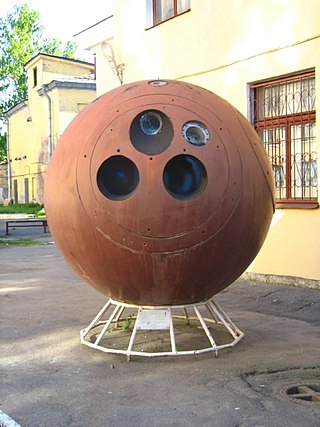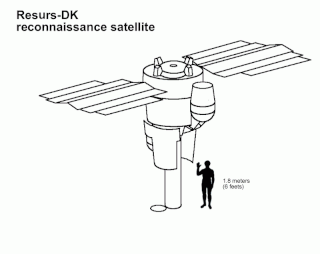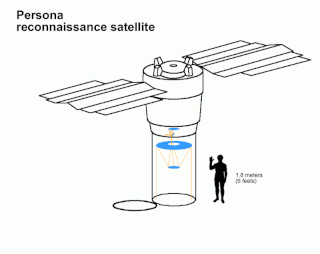
The Soyuz programme is a human spaceflight programme initiated by the Soviet Union in the early 1960s. The Soyuz spacecraft was originally part of a Moon landing project intended to put a Soviet cosmonaut on the Moon. It was the third Soviet human spaceflight programme after the Vostok (1961–1963) and Voskhod (1964–1965) programmes.
Kosmos is a designation given to many satellites operated by the Soviet Union and subsequently Russia. Kosmos 1, the first spacecraft to be given a Kosmos designation, was launched on 16 March 1962.

The Almaz program was a highly secret Soviet military space station program, begun in the early 1960s.

Zenit was a series of military photoreconnaissance satellites launched by the Soviet Union between 1961 and 1994. To conceal their nature, all flights were given the public Kosmos designation.

Soyuz-2 is a modernised version of the Soviet Soyuz rocket. In its basic form, it is a three-stage launch vehicle for placing payloads into low Earth orbit. Compared to the previous versions of the Soyuz, the first-stage boosters and two core stages feature uprated engines with improved injection systems. Digital flight control and telemetry systems allow the rocket to be launched from a fixed launch platform, whereas the launch platforms for earlier Soyuz rockets had to be rotated as the rocket could not perform a roll to change its heading in flight.

Resurs-DK No.1, also called Resurs-DK1, was a commercial Earth observation satellite capable of transmitting high-resolution imagery to the ground stations as it passed overhead. The spacecraft was operated by NTs OMZ, the Russian Research Center for Earth Operative Monitoring.
Kosmos 2175 was a Russian Yantar-4K2 photo reconnaissance satellite. It was the first satellite to be launched by the Russian Federation, following the breakup of the Soviet Union. It was launched by a Soyuz-U carrier rocket, flying from the Plesetsk Cosmodrome, on 21 January 1992.

GLONASS-K is the latest satellite design intended as a part of the Russian GLONASS radio-based satellite navigation system. Developed by ISS Reshetnev and first launched on 26 February 2011, it is a substantial improvement of the previous GLONASS-M second-generation satellites, having a longer lifespan and better accuracy.

Yantar is a series of Russian reconnaissance satellites, which supplemented and eventually replaced the Zenit spacecraft. Kosmos 2175, a Yantar-4K2 or Kobalt spacecraft, was the first satellite to be launched by the Russian Federation following the dissolution of the Soviet Union. Yantar-Terilen was the first real-time digital system. Yantar satellites also formed the basis for the later Orlets, Resurs and Persona satellites. 179 have been launched, nine of which were lost in launch failures. All Yantar satellites were launched using the Soyuz-U carrier rocket until Kosmos 2480 in 2012 which was announced as the last launch of that rocket from Plesetsk. Subsequent launches used the modernized Soyuz-2.1a rocket. The last Yantar mission was Kosmos 2505, a Yantar-4K2M or Kobalt-M, launched on 5 June 2015. Reconnaissance missions have been taken over by the Persona class of satellites.
Kosmos 4, also known as Zenit-2 No.2 and occasionally in the West as Sputnik 14 was the first Soviet reconnaissance satellite to successfully reach orbit.
Kosmos 7, also known as Zenit-2 No.4 and occasionally in the West as Sputnik 17 was a Soviet reconnaissance satellite launched in 1962. It was the seventh satellite to be designated under the Kosmos system, and the second successful launch of a Soviet reconnaissance satellite.
Kosmos 10, also known as Zenit-2 No.5, was a Soviet reconnaissance satellite launched in 1962. It was the tenth satellite to be designated under the Kosmos system, and the fourth successful launch of a Soviet reconnaissance satellite, following Kosmos 4, Kosmos 7 and Kosmos 9.

Kosmos 2441, also known as Persona No.1, was a Russian optical reconnaissance satellite launched in 2008. The first Persona satellite, it failed a few months into its mission, which was scheduled to have lasted three to five years. It was the first Russian reconnaissance satellite to be placed into a Sun-synchronous orbit.
EKSKupol is a developing programme of Russian early warning satellites as a replacement for the US-KMO and US-K satellites of the Oko programme. The satellites are designed to identify any possible future ballistic missile launches, from outer space, and complement early warning radars such as the Voronezh. This gives advance notice of a nuclear attack and would provide information to the A-135 missile defence system which protects Moscow, as well as other Russian missile defense and counterattack resources. Six satellites are planned to be initially orbited. The first of these was launched on 17 November 2015 and as of November 2022, all six of them are in service.

Kosmos 2480 is a Russian Kobalt-M reconnaissance satellite which was launched in 2012 by the Russian Aerospace Defence Forces. It was the last launch of a Soyuz-U rocket launched from Plesetsk Cosmodrome.
Kosmos 15 or Zenit-2 No.9 was a Soviet optical film-return reconnaissance satellite which was launched in 1963. A Zenit-2 spacecraft, Kosmos 15 was the ninth of eighty-one such satellites to be launched.

Resurs-P is a series of Russian commercial Earth observation satellites capable of acquiring high-resolution hyperspectral (HSI), wide-field multispectral (MSI), and panchromatic imagery. These spacecraft cost over 5 billion rubles and are operated by Roscosmos replacing the Resurs-DK No.1 satellite.
Cosmos-2445 was launched from the Plesetsk Cosmodrome on a Soyuz-U rocket on November 14, 2008. It is an optical reconnaissance Spacecraft of the Yantar-4K2M class. It re-entered on February 23, 2009, after 102 days in space It broke into two fragments that burned up later on in the re-entry sequence.
Kosmos 214 or Zenit-4 No.45 was a Soviet, optical film-return reconnaissance satellite launched in 1968. A Zenit-4 satellite, Kosmos 214 was the fortieth of seventy-six such spacecraft to be launched.











